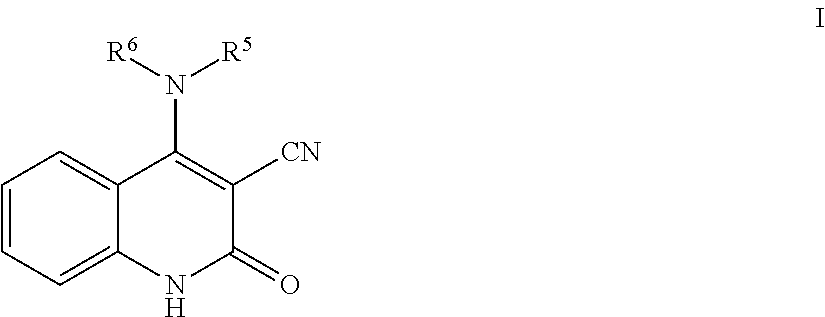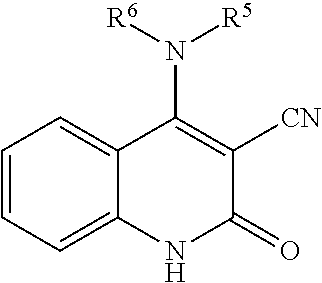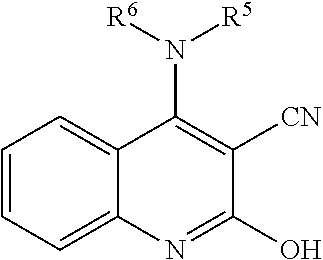Aza-cyanoquinolinone pde9 inhibitors
a technology of aza-cyanoquinolinone and pde9, which is applied in the field of compounds, can solve the problems of high non-compliance or discontinuation rate of medication, lack of efficacy, and dissatisfaction with therapy
- Summary
- Abstract
- Description
- Claims
- Application Information
AI Technical Summary
Benefits of technology
Problems solved by technology
Method used
Image
Examples
example 1
[0067]
(R)-4-(3-(1H-pyrazol-1-yl)pyrrolidin-1-yl)-2-oxo-1,2-dihydroquinoline-3-carbonitrile (1-7)
2,4-dihydroxyquinoline-3-carbonitrile (1-3)
[0068]To a round bottom flask, 2H-3,1-benzoxazine-2,4(1H)-dione (Aldrich, 82 g, 503 mmol) was added and dissolved in DMF (300 ml). Ethyl cyanoacetate 1-3 (62.5 g, 533 mmol) was then added slowly and the reaction was heated to 100° C. for 5 hours, at which point it was allowed to cool and poured into H2O. The H2O layer was acidified to pH 1 with 0.5M aqueous HCl, the precipitated solid was filtered and dried to give 2,4-dihydroxyquinoline-3-carbonitrile (1-3), HRMS (M+H)+: observed=187.1, calculated=187.1
2,4-dichloroquinoline-3-carbonitrile (1-4)
[0069]2H-3,1-benzoxazine-2,4(1H)-dione (1-3) (11.9 g, 63.8 mmol), POCl3 (44.0 g, 287 mmol) and POCl5 (26.6 g, 128 mmol) were added to a round bottomed flask and stirred at 100° C. for 2 hours. Upon completion, the reaction mixture was allowed to cool and slowly poured over ice mixture while stirring vigoru...
PUM
| Property | Measurement | Unit |
|---|---|---|
| Electrical conductance | aaaaa | aaaaa |
Abstract
Description
Claims
Application Information
 Login to View More
Login to View More - R&D
- Intellectual Property
- Life Sciences
- Materials
- Tech Scout
- Unparalleled Data Quality
- Higher Quality Content
- 60% Fewer Hallucinations
Browse by: Latest US Patents, China's latest patents, Technical Efficacy Thesaurus, Application Domain, Technology Topic, Popular Technical Reports.
© 2025 PatSnap. All rights reserved.Legal|Privacy policy|Modern Slavery Act Transparency Statement|Sitemap|About US| Contact US: help@patsnap.com



